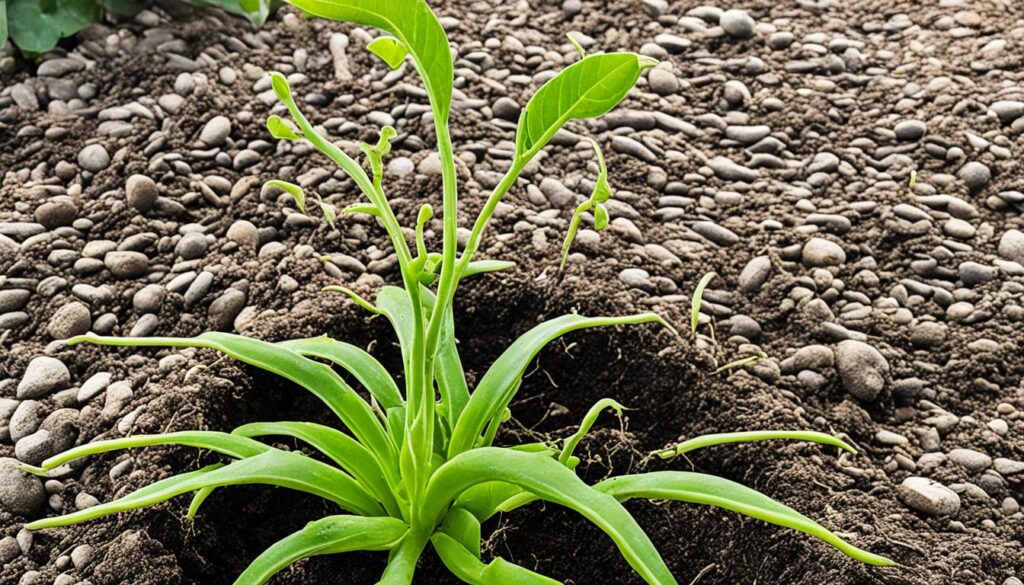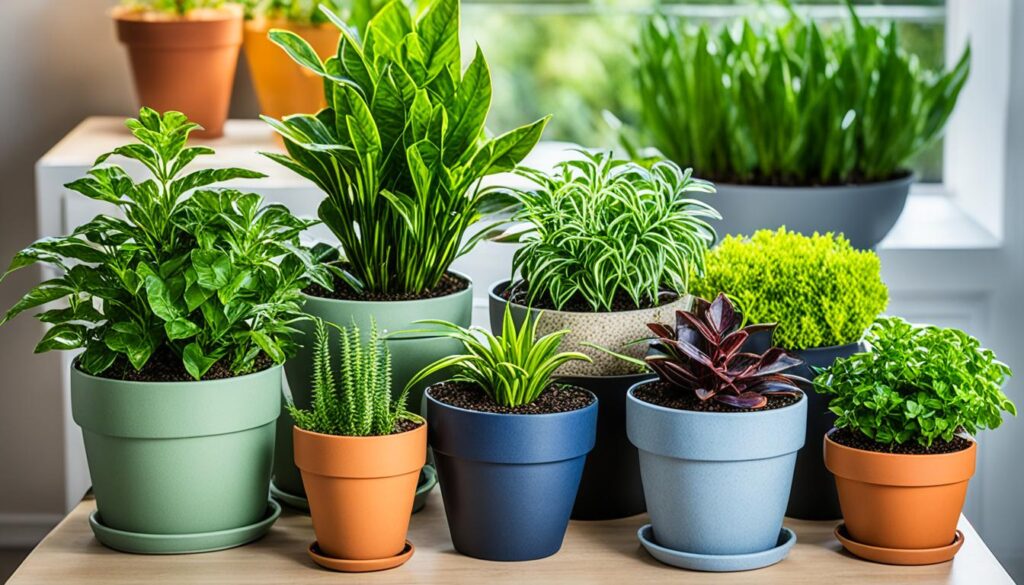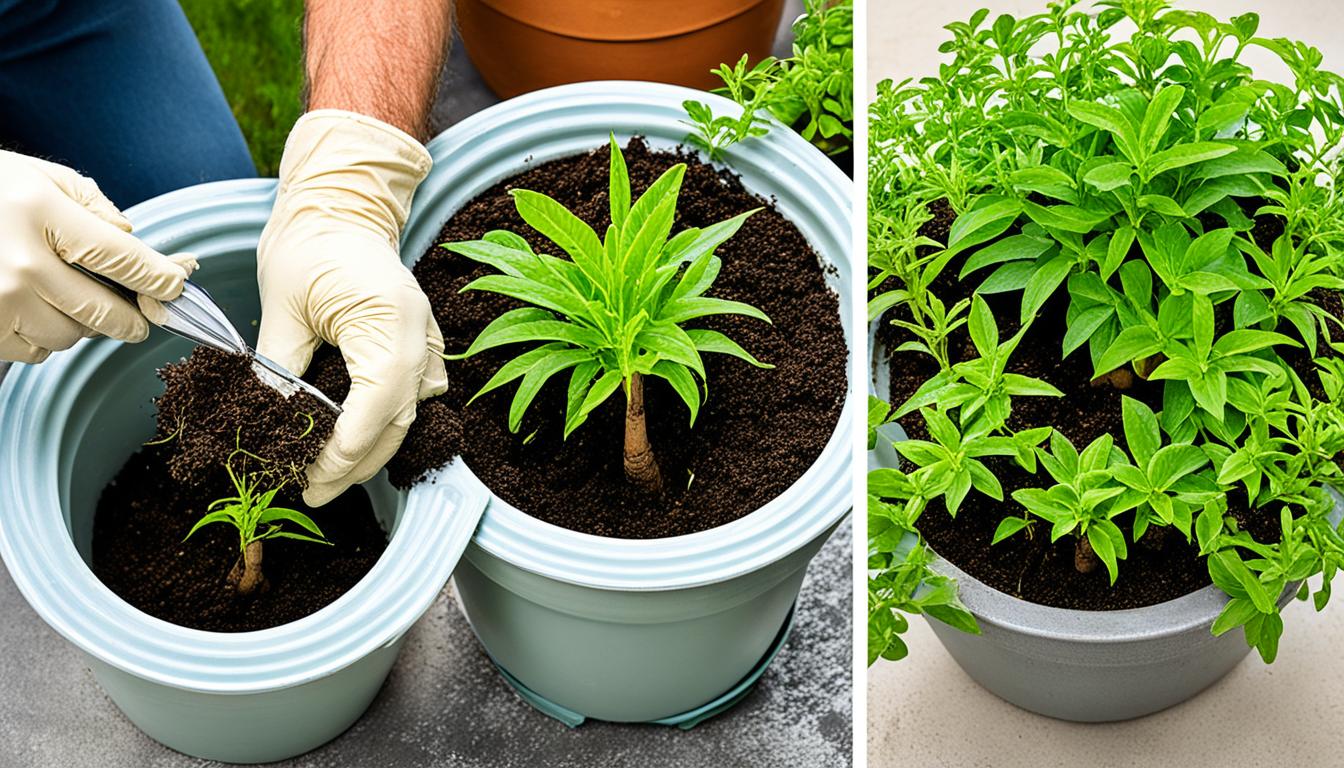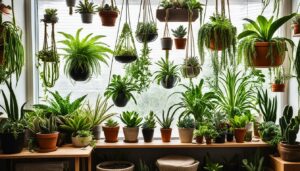Are you eager to breathe new life into your indoor plants but unsure of the best practices? Learning how to repot can help your plants flourish. We’ll share the secrets to revitalize your indoor plants through repotting. Let’s explore the when, why, and how of this important step.
Repotting indoor plants might seem tough, but it can be rewarding. By giving your plants enough space and fresh nutrients, you’ll help them grow strong.
The Importance of Repotting Indoor Plants
Repotting your indoor plants is key to their care. It gives them room to grow and refreshes the soil with nutrients. Knowing why this is important helps your plants stay healthy and bright.
Providing Room for Growth
As indoor plants grow, their roots spread and the soil gets packed. Not repotting them can cause wilted leaves and slow growth. Repotting lets roots grow and get the nutrients and moisture they need.
Replenishing Nutrients
The potting mix in indoor plant pots doesn’t last forever. Plants use up the nutrients, leaving the soil poor. By repotting with fresh mix, plants get the importance of repotting indoor plants for nutrients they need. This keeps the soil rich and plants healthy and green.
Understanding the importance of repotting indoor plants helps your houseplants grow well. This simple step is crucial for their health and beauty over time.
Signs Your Plant Needs Repotting
Knowing when your indoor plant needs a bigger pot is key for its health and growth. Watch for signs like behavior and appearance changes. This tells you when it’s time for a fresh, larger pot and nutrient-rich soil. Here are signs that show it’s time to repot your plant:
Roots Growing Through Drainage Holes
Seeing roots come out of the drainage holes means your plant has outgrown its pot. This shows the roots need more space. Moving it to a slightly bigger pot helps them keep growing well.
Plant Being Top-Heavy or Slow-Growing
If your plant looks top-heavy or is struggling to grow, it might be too small. A plant that’s unstable or slow-growing needs more space. Repotting gives it the room and resources to grow strong again.
Potting Mix Drying Out Quickly
Fast drying potting mix is another sign it’s time for a new pot. As plants grow, they use more water and nutrients. If you’re watering more often, it’s time for a bigger pot with fresh soil.
Watch for these signs to keep your indoor plants healthy and thriving. Being proactive with repotting ensures they have enough space and resources to grow strong.

When to Repot Indoor Plants
Timing is key when repotting indoor plants. Spring and early summer are the best times because plants grow the most during this period. As days get longer and sunlight stronger, plants grow more leaves and bounce back fast from repotting.
On the other hand, avoid repotting in winter. Plants are dormant then and may not handle the change well. This could slow down their growth and health.
Optimal Repotting Schedule
- Repot your indoor plants every 12-24 months, or when you notice the roots growing through the drainage holes.
- Young, fast-growing plants may need to be repotted more frequently, often annually, to accommodate their rapid expansion.
- Slow-growing or mature plants can typically go 2-3 years between repottings.
| Plant Type | Repotting Frequency |
|---|---|
| Fast-growing plants | Annually |
| Slow-growing plants | Every 2-3 years |
By following the best time to repot indoor plants and the repotting indoor plants schedule, you can ensure your houseplants have the necessary room and nutrients to thrive and reach their full potential.
“The best time to repot indoor plants is when they’re actively growing, typically in the spring through early summer.”
Choosing the Right Pot and Potting Mix
Choosing the right pot and potting mix is key when repotting indoor plants. The right pot size for repotting indoor plants and good pot drainage for repotting indoor plants can make a big difference. Also, picking the right potting mix for indoor plants gives your plants the nutrients and air they need to thrive.
Pot Size and Drainage
The best pot size for repotting indoor plants is 1-2 inches wider than the old one. This size lets the roots grow and prevents the soil from getting too wet. Make sure the new pot for repotting indoor plants has good pot drainage. This helps prevent root rot and other problems from too much moisture.
Potting Mix for Indoor Plants
For potting mix for indoor plants, choose a mix made for indoor plants. These mixes have the right nutrients, keep moisture in, and allow good air flow. Mixing the potting mix with an orchid mix can also help. It gives your plants the best balance of food and air.

By picking the right pot size for repotting indoor plants, making sure it drains well, and using a top-notch potting mix for indoor plants, you can help your houseplants do great. This way, you can enjoy a beautiful, green indoor space.
Step-by-Step Guide to Repotting Indoor Plants
Repotting your indoor plants can give them a new lease on life. It’s a simple way to help them grow better. If your plants are too big for their pots or need more nutrients, follow this guide to how to repot indoor plants and boost their growth.
Start by watering your plants well, making the soil moist. This makes it easier to remove the plant from its pot. Turn the plant upside down and carefully take it out, keeping the roots together.
- Look at the roots. If they’re wrapped around each other or poking out of the pot, it’s time for a bigger pot. Use clean pruning shears to cut off any dead or damaged roots.
- Pick a new pot that’s 2-4 inches wider than the old one. It should have good drainage holes to prevent water from pooling.
- Put a layer of fresh, quality potting mix for indoor plants at the bottom of the new pot. Place the plant in the middle and fill in around it with soil, pressing gently to remove air pockets.
- Water the plant well to settle the soil. Make sure it’s moist. Then, put it in a spot with the right amount of light for its type.
By following these steps to repot indoor plants, you’ll give your plants the space and care they need to do well. Embrace the repotting indoor plants process and watch your plants bloom!
| Pot Size | Plant Size |
|---|---|
| 4-6 inches | Small to medium |
| 6-8 inches | Medium to large |
| 8-10 inches | Large to extra-large |
Successful repotting indoor plants means giving them the right pot and fresh soil. By using this guide, you’ll create the best conditions for your plants to grow and flourish.
When to Repot Indoor Plants
Knowing when to repot your indoor plants is key for their health and growth. Typically, you should repot them every 1-2 years, based on their size and growth speed. Fast-growing plants might need more frequent repotting to get enough space and nutrients.
But, don’t rush the repotting process. Moving plants to bigger pots too early can slow their growth, delay blooms, and increase root rot risk. Wait until your plant has outgrown its pot before repotting.
Signs It’s Time to Repot
- Roots are growing through the drainage holes of the pot.
- The plant appears top-heavy or is growing slowly.
- The potting mix dries out quickly, even with regular watering.
Watch for these signs to repot your indoor plants at the best time. This ensures they get the right conditions for growth and health.
The when to repot indoor plants and how often to repot indoor plants can change with the plant type and conditions. Always check with a gardening expert or the plant’s care guide for the best repotting indoor plants schedule for your garden.
“Proper repotting is essential for the long-term health and vitality of your indoor plants.”
Conclusion
Repotting your indoor plants is key to keeping them healthy and growing well. Knowing when to repot, choosing the right pot and soil, and following a clear process are important. This ensures your houseplants stay happy and vibrant for many years.
Repotting your plants has many benefits, like making them stronger and living longer. With this repotting indoor plants guide, you can do it right and see your plants flourish.
Adding these tips to your plant care routine makes sure your plants last longer. It also helps create a beautiful indoor garden. By repotting your plants well, you show you care and see them grow and change beautifully.
FAQ
What are the signs that my indoor plant needs to be repotted?
Look for these signs: roots poking out of drainage holes, the plant feeling top-heavy or growing slowly, or the soil drying out too fast.
What is the best time of year to repot my indoor plants?
Spring and early summer are the best times. This is when your plants grow the most.
How often should I repot my indoor plants?
Repot your plants every 1-2 years. This depends on how big the plant is and how fast it grows.
What size pot should I use when repotting my indoor plants?
Choose a pot that’s only a bit bigger than the old one. Aim for 1-2 inches wider to prevent root problems.
What type of potting mix should I use when repotting my indoor plants?
Pick a soil mix made for indoor plants. Mixing it with orchid mix gives the right balance of nutrients, moisture, and air for your plants.





